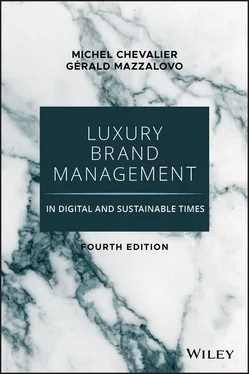To develop a fully fledged business, it becomes necessary to enlarge and diversify the product line to increase the sales volume on which to advertise. If Calvin Klein was extremely well known in the United States, he was relatively unknown in Europe and Asia until his perfume line was advertised heavily and became a success. On the back of this success, he was able to open stores for his fashion lines in Europe and Japan.
This process of line extension—moving away from one product category to another one—is particularly delicate for luxury goods. It took seven years for the first Bulgari watch to be successful. It took approximately the same time for Boucheron watches to start selling. While the psychological distance from jewelry to watches may seem very slight, it still takes a lot of time for the consumer to get used to the shift.
Some extensions have been more rapid and without apparent problems. When Prada went from shoes to handbags and then into the ready-to-wear field for women and men, it worked almost every time. The same thing happened with Gucci in its line extensions.
Other cases have been more delicate. In the 1990s, Christofle decided that tableware was not a fast-growing market. Recalling its origins as silversmiths, it decided to launch a jewelry line, opting for white gold. After the launch of its first collection, it produced a watch, also in white gold. But the company moved too far away from its traditional area of expertise and failed to make sufficient investment in advertising and promotion; the first extension did not work and proved to be a major setback for the brand.The second one is in the process today.
When Chanel decided to extend into jewelry, it was much more careful, launching a single model of watch from free-standing boutiques set up specifically for this purpose in Place Vendôme and Avenue Montaigne in Paris. The watch was a success. The company waited another four or five years before setting up a very large jewelry store in Place Vendôme, the best location for major jewelers in Paris. This, too, was a success.
Baccarat provides another interesting story. It was selling crystal glasses and facing the same problem as Christofle: difficulty in the tableware market. The company decided to concentrate on lamps and candle-holders for the home and to move into crystal jewelry pieces. It invested heavily, gave the best locations in its stores to this product line, and today, diversification products represent the majority of the brand's total sales.
The conditions governing line extensions can be summarized as follows:
Never believe it will be easy.
Make a major investment and a major effort.
Do not start small as a side business.
Do not believe that consumers will be immediately convinced. Give them time.
Emphasize coherence and style.
Find a credible reason why the new product line is appropriate for your brand.
Of course, with time and investment, everything is possible. But a careful review at the outset of the differences and the major issues the new product category will bring to the brand is vital.
A Mercedes sedan or BMW, whatever the model, is instantly identifiable. There can be no mistaking the design, the workmanship, or the overall appearance.
When someone makes the investment to buy a luxury product, it goes without saying that the service should be perfect, the product should be of exceptional quality, and it should be made as if it were a unique object, handcrafted or carefully prepared for the individual purchaser. But it needs something else. It needs to have a high aesthetic value. It should be part of a family of products and be clearly identified. Each brand should have its own aesthetic codes and maintain a strong coherence across its entire range of products. A Chanel perfume bottle is classic, simple, and sophisticated. A Saint Laurent jacket should look like no other, and its perfume bottles should be romantic, baroque, and feminine. There should be instant recognition.
The Primacy of Design.Design should be considered a priority in almost every luxury activity. This is obvious for a fashion brand, but it is also the case for a watch or a perfume. In fact, in creating a perfume, two different creative teams are involved: the “nose” that develops the fragrance and the designer for the bottle in which it is presented. With perfumes, there should also be a family homogeneity of fragrances within the same brand (Guerlain fragrances, for example, are generally quite heavy, with a vanilla heart note—the fragrance that lingers an hour or two after application), and each product should bring additional value to the total picture. That is to say, a Saint Laurent men's suit should have something in common with a women's dress from the same house.
This is why, for a luxury brand, management should be able to communicate with all types of designers. They should have a common language and a common understanding that enables them to discuss all aspects of a new product.
The Raison d'Être.Each object in the collection should add to the brand and have a reason for being. When Armani, for example, makes optical frames, they should not simply be standard glasses with an Armani label: they should have something special. For each new product line, the product category needs to be reinvented in line with the brand's ethical and aesthetic invariants, the two basic components of any brand identity, as we will explain in Chapter 6.
This is why the licensing of products without the brand studio retaining real control and real guidance is now mostly over. For many years, Rochas, which had been a full fashion line and had become a perfume house, had a women's ready-to-wear license in Japan. Lancel was a leather-goods company in Europe, but in Japan it had a whole collection of licensed products from women's ready-to-wear to panties, shoes, men's shirts and socks. This was perfectly all right in the 1960s and 1970s when luxury consumers were traveling less and when brand information was less available. Today such licensed products have a major drawback. All the customers who are knowledgeable about the brand refuse to buy them, and the products slip down to a consumer category less interested, less aware, and less demanding; they rapidly become middle-market brands.
In a way, these are simply standard positioning principles, as they apply to any marketing product analysis. For luxury items, however, we must go back to the concept of craftsmanship and what differentiates such items from mass-market products. A luxury object must be crafted and designed carefully. This is as true for a luxury fragrance as it is for a dress or a jacket. The sophistication of a luxury perfume should be matched by that of its presentation. Every element of the product should be carefully thought out—from the bottle to the inner and outer packaging—to give the consumer a sense of quality and perfect design every time. The distinction between a luxury product and a mass-market product is evident in the presentation of the jars of the anti-wrinkle creams of Plenitude de L'Oréal and of Lancôme. They are both manufactured by the same company, yet the shapes, weights, and finishes are quite different.
However, given that mass-market products are gradually upgrading their appearance and approach, it is even more important for luxury goods to work harder to stay ahead of the pack.
Craftsmanship should be the hallmark of all categories of luxury goods, and any product bearing a particular luxury brand should display all the ethical and aesthetic values that belong to that brand.
The Social and Cultural Environment
This ethical and aesthetic dimension has another effect. It places the luxury industry in the realm of the arts and into the cultural trends of the moment. As it looks for new shapes, colors, feelings, or modes of consumption, this industry is much more a part of the cultural scene than any others. Thus, its advertising bypasses traditional processes and looks for a special aesthetic environment and a special artistic connivance with its consumer target. In this, luxury products must function as a cultural mirror.
Читать дальше












